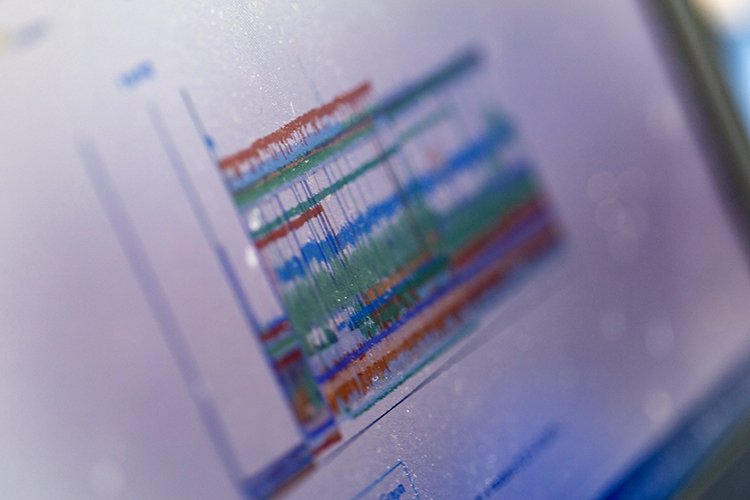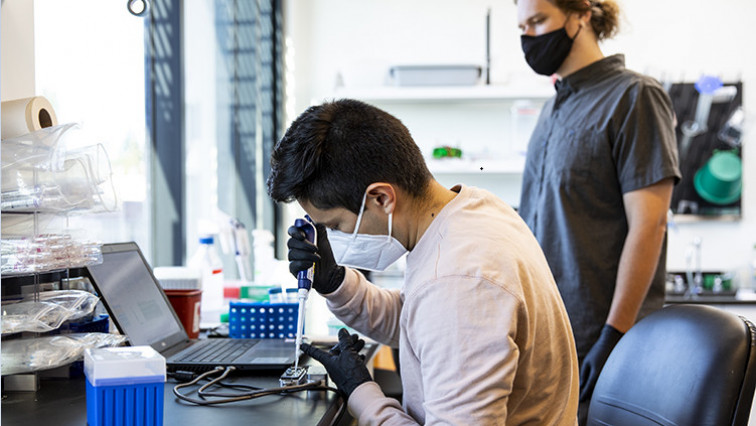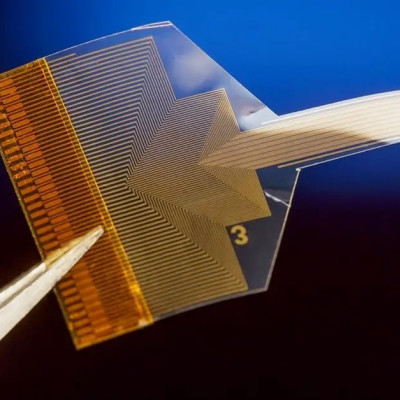In a paper published today in the journal Nature Biotechnology, members of the Molecular Information Systems Laboratory housed at the UW’s Paul G. Allen School of Computer Science & Engineering introduce a new class of reporter proteins that can be directly read by a commercially available nanopore sensing device. The new system ― dubbed “Nanopore-addressable protein Tags Engineered as Reporters,” also known as NanoporeTERs or NTERs for short ― can perform multiplexed detection of protein expression levels from bacterial and human cell cultures far beyond the capacity of existing techniques.
You could say the new system offers a “nanopore-tal” into what is happening inside these complex biological systems where, up until this point, scientists have largely been operating in the dark.
“NanoporeTERs offer a new and richer lexicon for engineered cells to express themselves and shed new light on the factors they are designed to track. They can tell us a lot more about what is happening in their environment all at once,” said co-lead author Nicolas Cardozo, a graduate student in the UW’s molecular engineering Ph.D. program. “We’re essentially making it possible for these cells to ‘talk’ to computers about what’s happening in their surroundings at a new level of detail, scale and efficiency that will enable deeper analysis than what we could do before.”
Conventional methods that employ optical reporter proteins, such as green fluorescent protein (GFP), are limited in the number of distinct genetic outputs that they can track simultaneously due to their overlapping spectral properties. For example, it’s difficult to distinguish between more than three different fluorescent protein colors, limiting multiplexed reporting to a maximum of three outputs. In contrast, NTERs were designed to carry distinct protein “barcodes” composed of strings of amino acids that, when used in combination, enable a degree of multiplexing approaching an order of magnitude more. These synthetic proteins are secreted outside of the cell into the surrounding environment, where they are collected and directly analyzed using a commercially available nanopore array — in this case, the Oxford Nanopore Technologies MinION device. To make nanopore analysis possible, the NTER proteins were engineered with charged “tails” that get pulled into the tiny nanopore sensors by an electric field. Machine learning is then used to classify their electrical signals in order to determine the output levels of each NTER barcode.
“This is a fundamentally new interface between cells and computers,” explained Allen School research professor and corresponding author Jeff Nivala. “One analogy I like to make is that fluorescent protein reporters are like lighthouses, and NanoporeTERs are like messages in a bottle. Lighthouses are really useful for communicating a physical location, as you can literally see where the signal is coming from, but it’s hard to pack more information into that kind of signal. A message in a bottle, on the other hand, can pack a lot of information into a very small vessel, and you can send many of them off to another location to be read. You might lose sight of the precise physical location where the messages were sent, but for many applications that’s not going to be an issue.”

Raw nanopore signals streaming from the MinION device, which contains an array of hundreds of nanopore sensors; each color represents data from an individual nanopore. The team uses machine learning to interpret these signals as NanoporeTERs barcodes.
In developing this new, more expressive vessel, Nivala and his colleagues eschewed time-consuming sample preparation or the need for other specialized laboratory equipment to minimize both latency and cost. The NTERs scheme is also highly extensible. As a proof of concept, the team developed a library of more than 20 distinct tags; according to co-lead author Karen Zhang, the potential is significantly greater.
“We are currently working to scale up the number of NTERs to hundreds, thousands, maybe even millions more,” Zhang, who graduated this year from the UW with bachelor’s degrees in biochemistry and microbiology, explained. “The more we have, the more things we can track. We’re particularly excited about the potential in single-cell proteomics, but this could also be a game-changer in terms of our ability to do multiplexed biosensing to diagnose disease and even target therapeutics to specific areas inside the body. And debugging complicated genetic circuit designs would become a whole lot easier and much less time consuming if we could measure the performance of all the components in parallel instead of by trial and error.”
MISL researchers have made novel use of the ONT MinION device before. Allen School alumna Kathryn Doroschak (Ph.D., ‘21), one of the lead co-authors of this paper, was also involved in an earlier project in which she and her teammates developed a molecular tagging system to replace conventional inventory control methods. That system relied on barcodes comprising synthetic strands of DNA that could be decoded on demand using the portable ONT reader. This time, she and her colleagues went a step further in demonstrating how versatile such devices can be.
“This is the first paper to show how a commercial nanopore sensor device can be repurposed for applications other than the DNA and RNA sequencing for which they were originally designed,” explained Doroschak. “This is exciting as a precursor for nanopore technology becoming more accessible and ubiquitous in the future. You can already plug a nanopore device into your cell phone; I could envision someday having a choice of ‘molecular apps’ that will be relatively inexpensive and widely available outside of traditional genomics.”
Read the original article on University of Washington.







